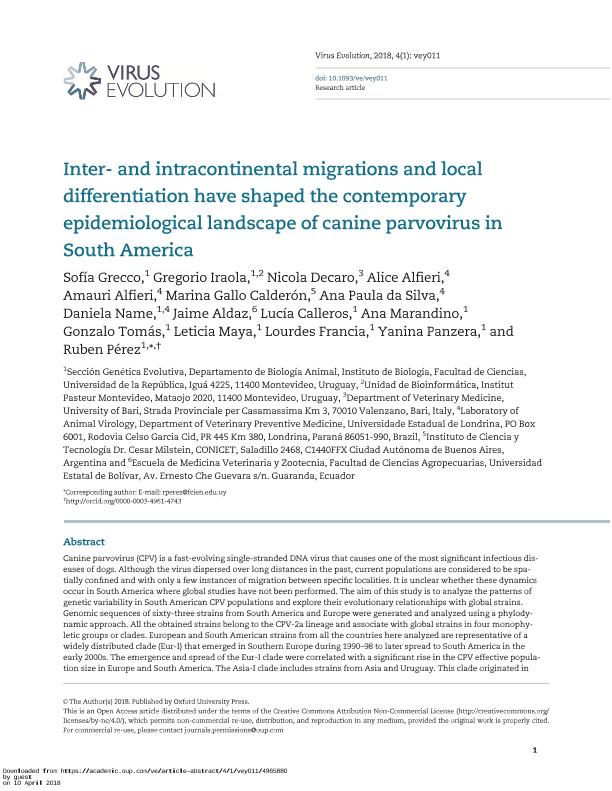Mostrar el registro sencillo del ítem
dc.contributor.author
Grecco, Sofia
dc.contributor.author
Iraola, Gregorio
dc.contributor.author
Decaro, Nicola
dc.contributor.author
Alfieri, Alice
dc.contributor.author
Alfieri, Amauri
dc.contributor.author
Gallo Calderon, Marina Beatriz

dc.contributor.author
da Silva, Ana Paula
dc.contributor.author
Name, Daniela
dc.contributor.author
Aldaz, Jaime
dc.contributor.author
Calleros, Lucia
dc.contributor.author
Marandino, Ana
dc.contributor.author
Gonzalo, Tomas
dc.date.available
2020-01-31T18:56:26Z
dc.date.issued
2018-04
dc.identifier.citation
Grecco, Sofia; Iraola, Gregorio; Decaro, Nicola; Alfieri, Alice; Alfieri, Amauri; et al.; Inter- and intracontinental migrations and local differentiation have shaped the contemporary epidemiological landscape of canine parvovirus in South America; Oxford University Press; Virus evolution; 4-2018
dc.identifier.issn
2057-1577
dc.identifier.uri
http://hdl.handle.net/11336/96406
dc.description.abstract
Canine parvovirus (CPV) is a fast-evolving single-stranded DNA virus that causes one of the most significant infectious diseasesof dogs. Although the virus dispersed over long distances in the past, current populations are considered to be spatiallyconfined and with only a few instances of migration between specific localities. It is unclear whether these dynamicsoccur in South America where global studies have not been performed. The aim of this study is to analyze the patterns ofgenetic variability in South American CPV populations and explore their evolutionary relationships with global strains.Genomic sequences of sixty-three strains from South America and Europe were generated and analyzed using a phylodynamicapproach. All the obtained strains belong to the CPV-2a lineage and associate with global strains in four monophyleticgroups or clades. European and South American strains from all the countries here analyzed are representative of awidely distributed clade (Eur-I) that emerged in Southern Europe during 1990?98 to later spread to South America in theearly 2000s. The emergence and spread of the Eur-I clade were correlated with a significant rise in the CPV effective populationsize in Europe and South America. The Asia-I clade includes strains from Asia and Uruguay. This clade originated in Asia during the late 1980s and evolved locally before spreading to South America during 2009?10. The third clade (Eur-II)comprises strains from Italy, Brazil, and Ecuador. This clade appears in South America as a consequence of an early introductionfrom Italy to Ecuador in the middle 1980s and has experienced extensive local genetic differentiation. Some strainsfrom Argentina, Uruguay, and Brazil constitute an exclusive South American clade (SA-I) that emerged in Argentina in the1990s. These results indicate that the current epidemiological scenario is a consequence of inter- and intracontinentalmigrations of strains with different geographic and temporal origins that set the conditions for competition and local differentiationof CPV populations. The coexistence and interaction of highly divergent strains are the main responsible for thedrastic epidemiological changes observed in South America in the last two decades. This highlights the threat of invasionfrom external sources and the importance of whole-genome resolution to robustly infer the origin and spread of new CPVvariants. From a taxonomic standpoint, the findings herein show that the classification system that uses a single aminoacid to identify variants (2a, 2b, and 2c) within the CPV-2a lineage does not reflect phylogenetic relationships and is not suitableto analyze CPV evolution. In this regard, the identification of clades or sublineages within circulating CPV strains is thefirst step towards a genetic and evolutionary classification of the virus.
dc.format
application/pdf
dc.language.iso
eng
dc.publisher
Oxford University Press
dc.rights
info:eu-repo/semantics/openAccess
dc.rights.uri
https://creativecommons.org/licenses/by-nc-sa/2.5/ar/
dc.subject
PARVOVIRUS
dc.subject
CANINO
dc.subject.classification
Epidemiología

dc.subject.classification
Ciencias de la Salud

dc.subject.classification
CIENCIAS MÉDICAS Y DE LA SALUD

dc.title
Inter- and intracontinental migrations and local differentiation have shaped the contemporary epidemiological landscape of canine parvovirus in South America
dc.type
info:eu-repo/semantics/article
dc.type
info:ar-repo/semantics/artículo
dc.type
info:eu-repo/semantics/publishedVersion
dc.date.updated
2020-01-30T22:00:46Z
dc.journal.pais
Reino Unido

dc.description.fil
Fil: Grecco, Sofia. Universidad de la República; Uruguay
dc.description.fil
Fil: Iraola, Gregorio. Universidad de la República; Uruguay
dc.description.fil
Fil: Decaro, Nicola. Università degli Studi di Bari; Italia
dc.description.fil
Fil: Alfieri, Alice. Universidade Estadual de Londrina; Brasil
dc.description.fil
Fil: Alfieri, Amauri. Universidade Estadual de Londrina; Brasil
dc.description.fil
Fil: Gallo Calderon, Marina Beatriz. Consejo Nacional de Investigaciones Científicas y Técnicas. Oficina de Coordinación Administrativa Parque Centenario. Instituto de Ciencia y Tecnología "Dr. César Milstein". Fundación Pablo Cassará. Instituto de Ciencia y Tecnología "Dr. César Milstein"; Argentina
dc.description.fil
Fil: da Silva, Ana Paula. Universidade Estadual de Londrina; Brasil
dc.description.fil
Fil: Name, Daniela. Universidad de la República. Facultad de Ciencias; Uruguay
dc.description.fil
Fil: Aldaz, Jaime. Universidad Estatal de Bolivar; Ecuador
dc.description.fil
Fil: Calleros, Lucia. Universidad de la República. Facultad de Ciencias; Uruguay
dc.description.fil
Fil: Marandino, Ana. Universidad de la República. Facultad de Ciencias; Uruguay
dc.description.fil
Fil: Gonzalo, Tomas. Universidad de la República. Facultad de Ciencias; Uruguay
dc.journal.title
Virus evolution
dc.relation.alternativeid
info:eu-repo/semantics/altIdentifier/doi/http://dx.doi.org/10.1093/ve/vey011
dc.relation.alternativeid
info:eu-repo/semantics/altIdentifier/url/https://academic.oup.com/ve/article/4/1/vey011/4965880
Archivos asociados
